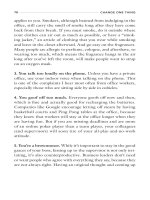The Project Gutenberg eBook, The Adventures of a Forty-niner, by Daniel Knower pdf
Bạn đang xem bản rút gọn của tài liệu. Xem và tải ngay bản đầy đủ của tài liệu tại đây (1.3 MB, 310 trang )
The Project
Gutenberg eBook,
The Adventures of
a Forty-niner, by
Daniel Knower
This eBook is for the use of anyone
anywhere at no cost and with
almost no restrictions whatsoever. You may
copy it, give it away or
re-use it under the terms of the Project
Gutenberg License included
with this eBook or online at
www.gutenberg.net
Title: The Adventures of a Forty-niner
Author: Daniel Knower
Release Date: June 4, 2004 [eBook
#12518]
Language: English
Character set encoding: iso-8859-1
***START OF THE PROJECT
GUTENBERG EBOOK THE
ADVENTURES OF A FORTY-
NINER***
E-text prepared by the Project
Gutenberg Online Distributed
Proofreading Team
THE
ADVENTURES
OF A FORTY-
NINER.
AN HISTORIC
DESCRIPTION OF
CALIFORNIA, WITH
EVENTS AND IDEAS OF
SAN FRANCISCO AND ITS
PEOPLE IN THOSE EARLY
DAYS.
By DANIEL
KNOWER.
1894
DEDICATED TO Colonel Jonathan
Stevenson, Colonel John C. Freemont, and
Captain John A. Sutter,
THE THREE PRE-EMINENT
PIONEERS OF CALIFORNIA.
PREFACE.
THE CALIFORNIA PIONEER
SOCIETY.
THE ADVENTURES OF A FORTY-
NINER.
A FEW HISTORICAL ITEMS.
HIS STORY.
THE GAMBLING OF THAT DAY.
THE GRIZZLY BEARS.
MY BLANKET MAN.
THE MAN IN HIS TENT.
THE CLIPPER SHIPS.
A BULL FIGHT.
HOME SICKNESS.
JESUIT MISSION STATIONS.
SCENES ON THE PACIFIC OCEAN.
PERORATION.
DEATH OF A FORMER
SCHOHARIAN.
APPENDIX.
PREFACE.
The discovery of gold in California, in
1848, with its other mineral resources,
including the Alamada quicksilver mine at
San José, which is an article of first
necessity in working gold or silver ore;
and the great silver mines of Nevada, in
1860, the Comstock lode, in which, in ten
years, from five to eight hundred millions
of gold and silver were taken out, a larger
amount than was ever taken from one
locality before, the Alamada quicksilver
mine being the second most productive of
any in the world, the one in Spain being
the largest, said to be owned by the
Rothschilds. Its effect upon the general
prosperity and development of our country
has been immense, almost incalculable.
Before these discoveries the amount of
gold in the United States was estimated at
about seventy millions, now it is conceded
to be seven hundred millions. The
Northern Pacific coast was then almost
unpopulated. California a territory three
times as large as New York and Oregon
and the State of Washington, all now being
cultivated and containing large and
populous cities, and railroads connecting
them with the East. Why that country
should have remained uninhabited for
untold ages, where universal stillness
must have prevailed as far as human
activity is concerned, is one of the
unfathomable mysteries of nature. It is
only one hundred and twenty-five years
since the Bay of San Francisco was first
discovered, one of the grandest harbors in
the world, being land-locked, extending
thirty miles, where all the vessels of the
world could anchor in safety. The early
pioneers of those two years immediately
after the gold was discovered (of which I
am writing) are passing away. As Ossian
says, "People are like the waves of the
ocean, like the leafs of woody marvin that
pass away in the rustling blast, and other
leaves lift up their green heads." There is
probably not five per cent of the
population of California to-day, of those
days, scenes and events of which I have
tried to portray. Another generation have
taken their places who can know but little
of those times except by tradition. I, being
one of the pioneers, felt it a duty, or an
inspiration seemed to come over me as an
obligation I owed to myself and
compatriots of those times, to do what I
could to perpetuate the memory of them to
some extent in the history of our country as
far as I had the ability to do it.
THE AUTHOR.
THE CALIFORNIA
PIONEER SOCIETY.
The California Pioneer Society was
organized in August, 1850. The
photograph of their building appears on
the cover of this book, W.D.M. Howard
was their first president. Among their
early presidents, and prominent in the
days of Forty-niners, were Samuel
Branan, Thomas Larkins, Wm. D.
Farewell, and James Lick—who liberally
endowed it.
perpetuating the memory of the events of
those days and for the benefit and mutual
protection of its members. No person was
eligible for membership except he had
arrived in California before the 1st of
January, 1850, and the descendants of
Forty-niners when arriving at the age of
twenty-one are eligible. At the opening of
the World's Fair in San Francisco in
January last, in the ceremonies in the
marching of the procession through the
streets of the city, they were received with
the greatest enthusiasm and cheers, which
was a marked manifestation of the
veneration in which they are held by the
people of California.
THE ADVENTURES
OF A FORTY-NINER.
The writer was practising his profession
in the city of Albany, his native place, in
1848, when reports came of the discovery
of gold in California. In a short time
samples of scales of the metal of the river
diggings were on exhibition, sent to
friends in the city in letters. Many of
Colonel Stevenson's regiment had been
recruited in that city. Soon these rumors
were exaggerated. It was said that barrels
of gold were dug by individuals named.
Soon the excitement extended all over the
country, and the only barrier to wealth, it
seemed, was the difficulty of getting to the
Eldorado. Why the discovery of gold there
should have produced so much excitement
cannot be fathomed. It seemed an era in
human affairs, like the Crusades and other
events of great importance that occur.
Your correspondent became one of its
votaries, and organized a company to go
to the gold rivers and secure a fortune for
all interested in it, and it seemed all that
was required was to get there and return
in a short time and ride in your carriage
and astonish your friends with your riches.
Suffice it to say, this company was fully
organized (with its by-laws and system of
government drawn up by the writer), and
sailed from the port of New York on the
ship Tarrolinter on the 13th of January,
1849, to go around Cape Horn, arriving in
San Francisco on the following July. From
that time I became absorbed in all the
news from the gold regions, and losing
confidence somewhat in the certainty of a
fortune from my interest in the company,
and reading of the high price of lumber,
the scarcity of houses, and the
extraordinary high wages of mechanics
there, conceived the project of shipping
the materials for some houses there,
having all the work put on them here that
could be done, thus saving the difference
in wages, and to have them arrive there
before the rainy season set in, and thus
realize the imaginary fortune that I had
expected from my interest in the company.
In the following spring I had twelve
houses constructed. The main point upon
which my speculation seemed to rest was
to get them to San Francisco before the
rainy season commenced. I went to New
York to secure freight for them in the
fastest vessel. Fortunately for me, as I
conceived at the time, I found the day
before I arrived in New York, the Prince
de Joinville, a Havre packet ship, had
been put up to sail for the port of San
Francisco, and as yet had engaged no
freight. I made a bargain with them at once
to take my houses at sixty cents per square
foot, and had the contract signed, half to
be delivered at the side of the ship by such
a date and the other half at a subsequent
date. I delivered the first half of the
houses on the time agreed, sending them
down the Hudson river by a barge on a
tow. I sent the second half on a barge to
get there on the day they were due,
apprehending no trouble, I going down
myself a few days in advance. They
commenced complaining at the ship that
they would not have room for the balance
of my houses on board, although I had
their written contract to take them at sixty
cents per foot.
There was great California excitement
about this time, and other parties had
come to the conclusion that the Prince de
Joinville was probably the fastest ship
taking freight for San Francisco. I saw
them accept of offers at $1.50 per foot,
when their contract with me was for less
than half that price, which would make a
difference of several thousand dollars in
their favor. So, if the balance of my
houses did not arrive within the time
stated in the contract, they would not be
taken on that vessel, and my speculation
ruined. The time was up the next day at
twelve o'clock. I was down on the Battery
the next morning early watching for the
tow, with the barge with my houses. The
ship was at the dock in the East river.
About ten o'clock, A.M., I had the good
fortune to see the barge rounding the
Battery. I cried out to the captain to cut
loose from the tow, employ the first steam
tug and I would pay the bill, which he did,
getting on the side of the vessel by eleven
o'clock, thus saving my contract by one
hour. But they did not commence taking
them on board, so the captain of the barge
put a demurrage of $20 per day for
detention. In the meantime, I had bought
my ticket to sail by the steamer Georgia to
the Isthmus to go on the 1st of July which
was but a few days off. They, seeing that I
had them on my contract, came to me and
said that my houses should go on their ship
according to contract, if they had to throw
other freight out, and that they would sign
a regular bill of lading for all the material
deliverable to me upon the arrival of the
Prince de Joinville at the port of San
Francisco, and take my carpenters'
specifications for the description of them,
which seemed all right to me.
The following is an article from the
Albany Evening Atlas of June 23, 1849:
"CALIFORNIA HOUSES.
"Our estimable fellow citizen Dr.
Knower, who is to start for California by









